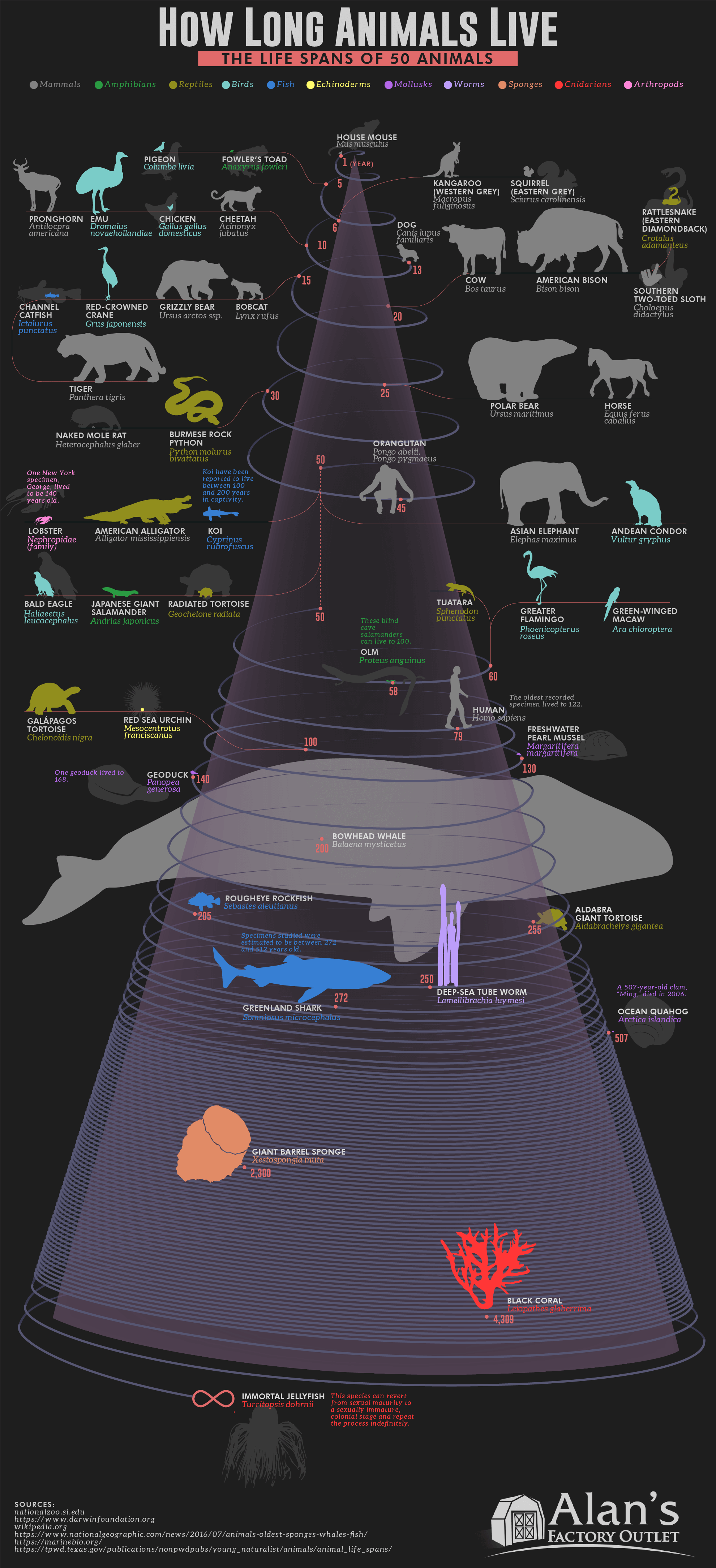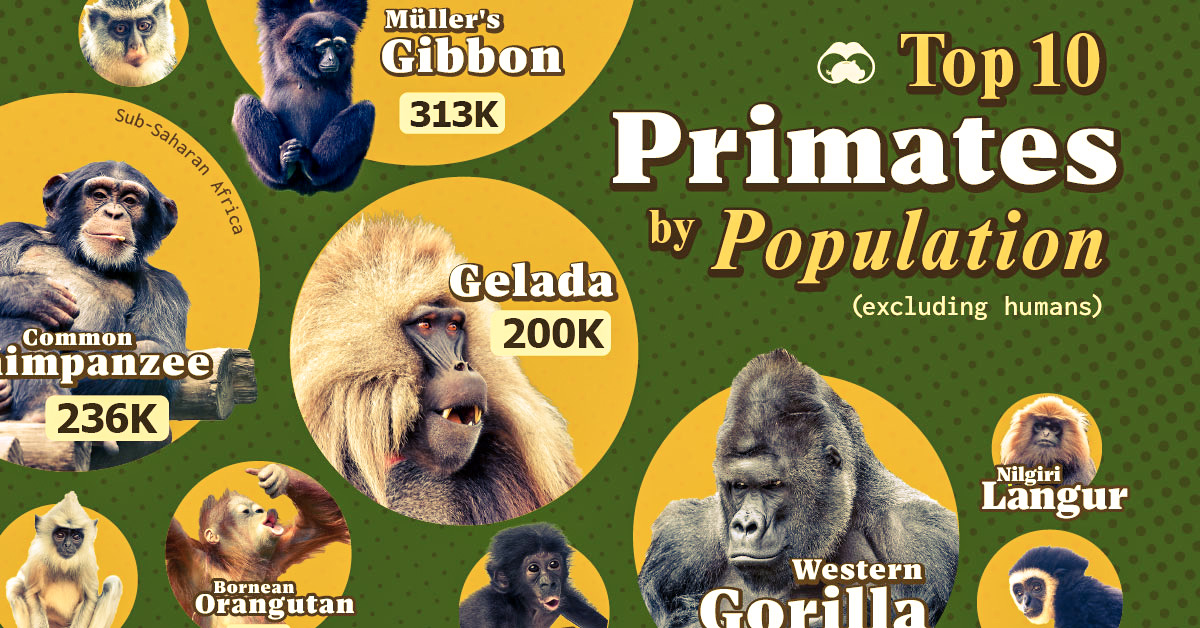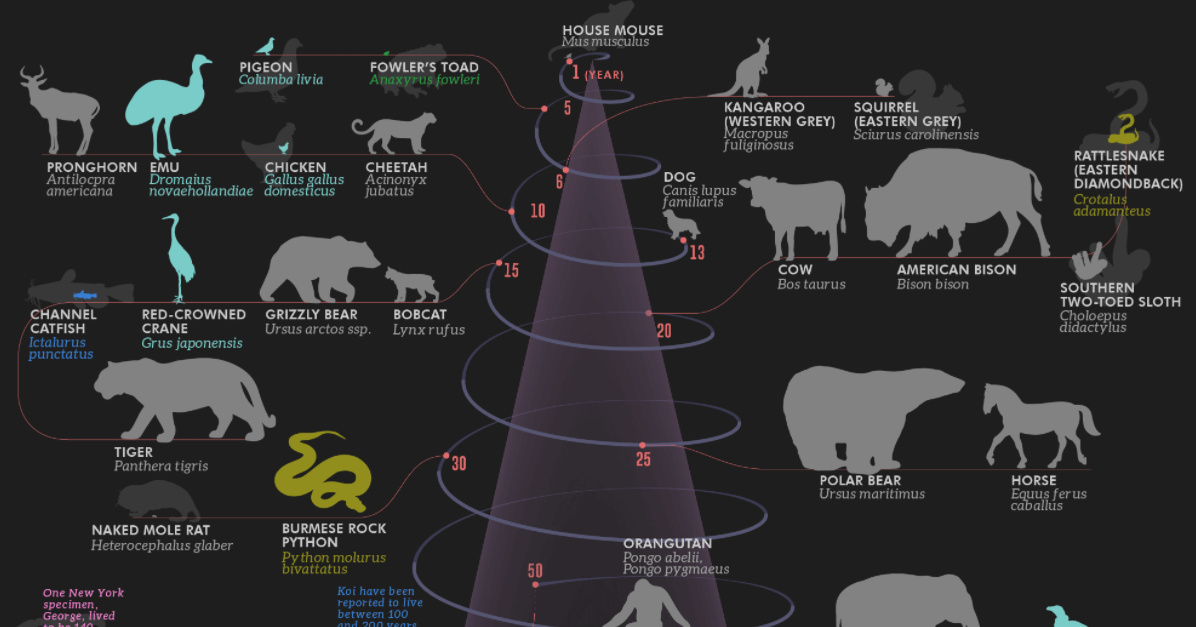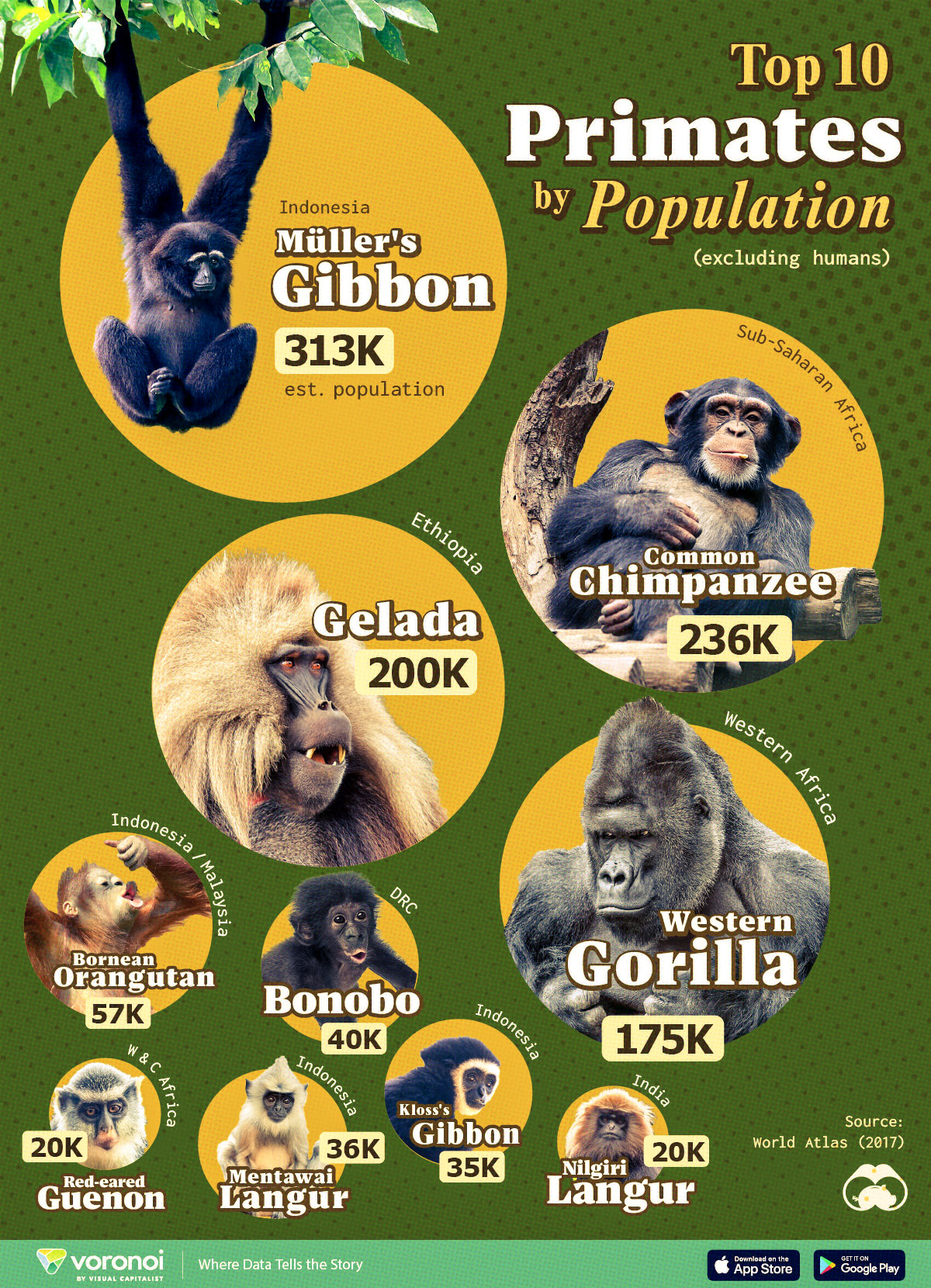Science
Ranked: The Life Expectancy of Humans and 49 Other Animals

Ranked: The Life Expectancy of Humans and 49 Other Animals
For most of history, average life expectancy at birth for humans has stood around 30 years. But thanks to recent breakthroughs in technology and modern medicine, humans are now born with an average life expectancy closer to 80 years.
Some might argue this is one of mankind’s greatest achievements. With this rise in life expectancy, how do human lifespans now rank compared to other animals?
This graphic from Alan’s Factory Outlet covers the life expectancy of 50 different animals ranging from amphibians to arthropods, and even includes one species that’s immortal (well, in theory).
Let’s take a closer look at lifespans in the animal kingdom.
The Longest Living Things
Here are some of the longest living animals, where even with advancements in modern medicine, humans are likely far off from matching.
The Deep-Sea Tube Worm
The deep-sea tube worm, also known as Riftia pachyptila, lives until about 250 years old, though in some cases this can stretch much further.
Amazingly, they have no digestive system, mouth, or anus, and thus do not consume food to survive in a traditional sense. Instead, the bacteria living inside their bodies helps to transform the sulfur from nearby hydrothermal vents into energy.
This makes the deep-sea tube worm one of the few animals on Earth that does not derive its nutrients (either directly or indirectly) from sunlight.
The Immortal Jellyfish
The immortal jellyfish, otherwise known as Turritopsis dohrnii, is biologically immortal.
How is this possible?
Essentially, these creatures revert and transition backwards from sexual maturity towards sexual immaturity in a process called transdifferentiation—where adult cells are converted into other types of tissue. Not surprisingly, processes like these are getting plenty of human attention in gene therapy and scientific research.
Giant Barrel Sponge
The giant barrel sponge can live for 2,300 years. These cool creatures live on the reef surface of the ocean, and are bowl shaped, which provides habitat for many other invertebrates including crabs, shrimps, as well as fish. In addition, sponges have no tissue and each of their individual cells can do the same job of any other cell.
Some experiments have even shown sponges reform and have their cells swim back together when blended up in a blender. If they didn’t, that would be a very cruel experiment.
Human Lifespans: A Rising Trend To Watch
The number of centenarians—those 100 or more years old—stands at 570,000 today.
Here are the countries where they are most common compared to their respective populations.
| Country/Region | % Of Population |
|---|---|
| Japan | 0.062% |
| Uruguay | 0.061% |
| Hong Kong | 0.047% |
| Puerto Rico | 0.045% |
| France | 0.030% |
| Spain | 0.028% |
| Italy | 0.028% |
| Cuba | 0.027% |
While figures in the one-hundredth of a percent range may sound underwhelming, this is still a 1,500% jump from the 33,000 centenarians that lived in the 1950s.
Slowly but surely, as human life expectancy continues to grow, our species seems destined to climb up the age ladder—and who knows, we may even be able to eventually live beyond some of the other creatures on this list.
Science
What Are the 10 Most Common Primates in the World?
This list excludes humans, who would otherwise lead the ranks of most common primates by a significant margin.

What Are the 10 Most Common Primates in the World?
This was originally posted on our Voronoi app. Download the app for free on Apple or Android and discover incredible data-driven charts from a variety of trusted sources.
The word ‘primate’ traces its roots back to the Latin word ‘primas,’ meaning ‘of first rank’ or the highest order in the animal kingdom. This classification intuitively reflects humans’ fascination with the many species who are our closest cousins.
In this graphic, we visualize the top 10 species of primates, ranked by their estimated global population. This data comes from WorldAtlas, and was last updated in 2017.
Given the difficult nature of tracking wild animals, these numbers should be treated as approximations rather than exact figures.
Ranked: Top 10 Primates, by Population
At the top of the list, there are more than 300,000 Müller’s Bornean Gibbons in the world, found on the island of Borneo in Indonesia and Malaysia.
The larger gibbon family consists of around 20 species of small apes found swinging through Southeast Asian rainforests. These acrobatic primates are known for their loud calls, impressive agility, and monogamous family structures.
Despite their ape status, they differ from great apes by being smaller and lacking nests.
| Rank | Monkey | Region of Origin | Estimated Population (as of 2017) |
|---|---|---|---|
| 1 | Muller's Bornean Gibbon | 🇮🇩 Indonesia | 312,500 |
| 2 | Common Chimpanzee | 🌍 Sub-Saharan Africa | 236,200 |
| 3 | Gelada | 🇪🇹 Ethiopia | 200,000 |
| 4 | Western Gorilla | 🌍 Western Africa | 175,000 |
| 5 | Bornean Orangutan | 🇮🇩 Indonesia / 🇲🇾 Malaysia | 57,000 |
| 6 | Mentawai Langur | 🇮🇩 Indonesia | 36,000 |
| 7 | Bonobo | 🇨🇩 DRC | 39,750 |
| 8 | Kloss's Gibbon | 🇮🇩 Indonesia | 35,000 |
| 9 | Red-eared Guenon | 🌍 West & Central Africa | 20,000 |
| 10 | Nilgiri Langur | 🇮🇳 India | 20,000 |
Ranked second, the Common Chimpanzee can be found in the savannas and forests of sub-Saharan Africa. A subspecies—the Eastern Chimpanzees in Tanzania’s Gombe National Park—were the primary focus of noted biologist Jane Goodall’s pioneering research in the 1960s.
Despite their apparent numbers, chimpanzees are now classified as an endangered species by the UN, their survival threatened by habitat loss, poaching, and disease.
All the way across, in Ethiopia, the Gelada species is the third most populous primate on the planet. Their short, stump fingers make them adept rock climbers—useful for navigating the Semien mountains they call home.
At fourth place, the Western Gorilla, also found in Africa, is the last primate species with a population above 100,000. The Western Gorillas are a little smaller than their Eastern counterparts, who are the largest living primates.
See More Animal Graphics From Visual Capitalist
If you’re curious to learn more about animals, check out this graphic that ranks the top speeds of the world’s fastest animals.
-

 Mining2 weeks ago
Mining2 weeks agoCharted: The Value Gap Between the Gold Price and Gold Miners
-

 Real Estate1 week ago
Real Estate1 week agoRanked: The Most Valuable Housing Markets in America
-

 Business1 week ago
Business1 week agoCharted: Big Four Market Share by S&P 500 Audits
-

 AI1 week ago
AI1 week agoThe Stock Performance of U.S. Chipmakers So Far in 2024
-

 Misc1 week ago
Misc1 week agoAlmost Every EV Stock is Down After Q1 2024
-

 Money2 weeks ago
Money2 weeks agoWhere Does One U.S. Tax Dollar Go?
-

 Green2 weeks ago
Green2 weeks agoRanked: Top Countries by Total Forest Loss Since 2001
-

 Real Estate2 weeks ago
Real Estate2 weeks agoVisualizing America’s Shortage of Affordable Homes















